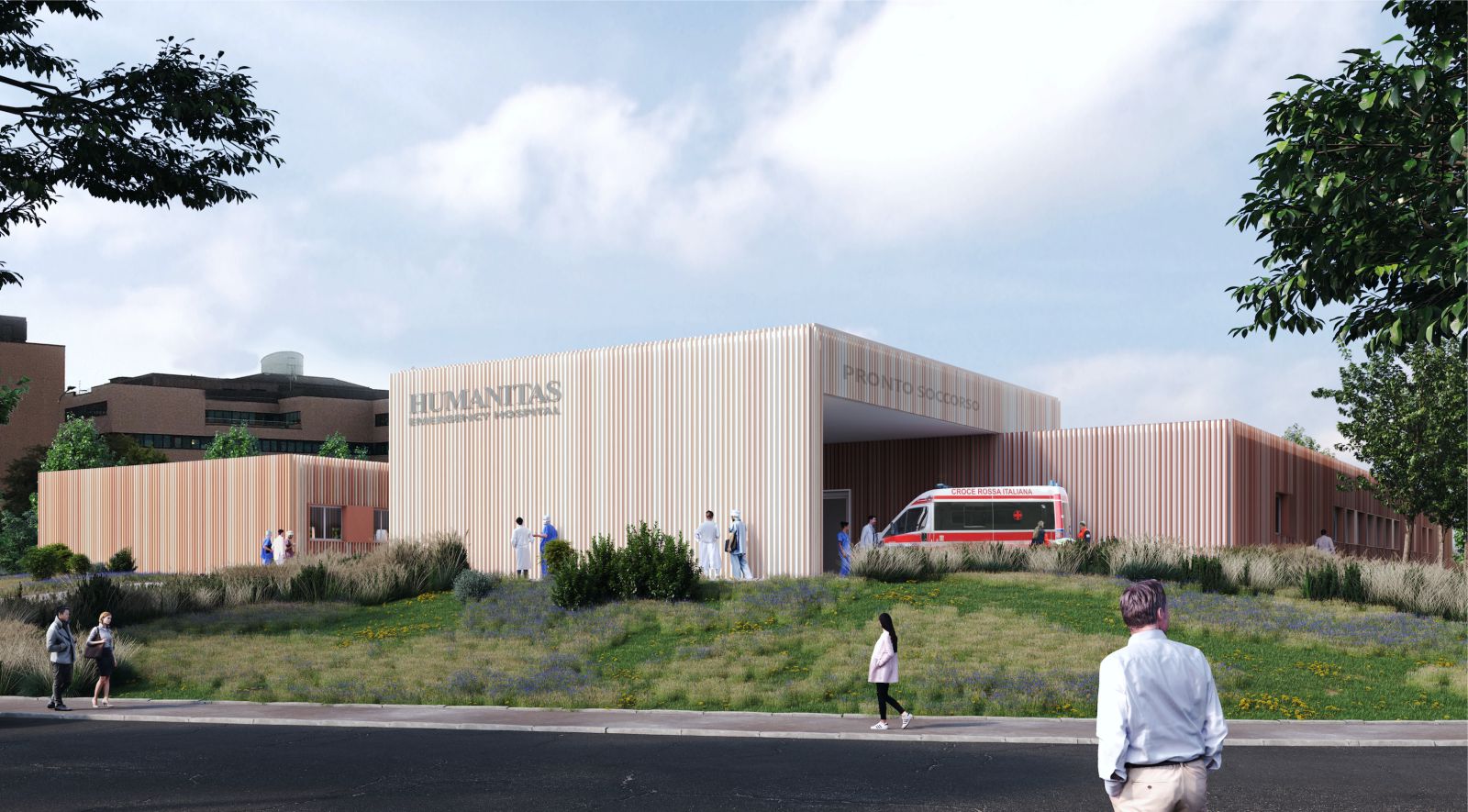Emergency Hospital 19 is a project developed by Humanitas, with the engineering and design support of Techint and architect Filippo Taidelli for the management and containment of infectious diseases within hospital facilities. Not just a concept, but a pilot project and a new model for managing healthcare emergencies with the aim of providing quality, safety and efficiency spaces.
Emergency Hospital 19 is Humanitas’s response to the need to be ready to manage the critical aspects of an emergency and normal healthcare at the same time: versatile, universally adaptable architecture – achievable in just 3 months – that starting from a modular structure can grow without constraints, be adapted to and integrated with the pre-existing context and have its spaces customised.
The humanised hospital and therapy as beauty
The project for Emergency Hospital 19 is based on the need to put man, a patient in today’s hospital, at the centre.The environment must become a resource for supporting the healing process: many factors related to the architectural dimension of the environment can have a positive influence on the healing process. Wards and intensive therapy units have large windows that allow the patient to benefit from natural light and a view of the landscape.
The rooms are defended against the risk of glaring sun or overheating by the presence of Venetian blinds and silkscreens beyond the window. In an emergency situation, the patient can often spend more than 10 days in a hospital ward, in small spaces that sometimes do not allow the presence of other furniture except a bed – which becomes a couch, dining room and sofa. In this habitat, the finish of the inner enclosure helps to infuse serenity and tranquillity into the patient.
In the Emergency Hospital 19 project the multicoloured pastel striped wallpaper in rooms and corridors breaks up the monotony and continuity between spaces. The floors, which simulate a seamless wooden deck, and the warm light fixtures (3000 k) also help to create a more enveloping atmosphere. These devices are designed to recreate domestic sensations of serenity and well-being, supporting the patient’s delicate psychophysical balance.
The sustainable hospital
Emergency Hospital 19 responds to an extended sustainability principle: technical, social, energetic and environmental. The basic module has been developed to be energetically autonomous, as well as adaptable to latitude and context. The building enclosure has been designed to reduce incoming thermal energy by up to 50%, thus reducing the energy required by the interior air conditioning. The more or less breathable double skin allows the building to adapt to different climatic conditions by making the most of the resources available on site (sun, wind, vegetation, etc. …)
Therapeutic green
Green areas are an essential part of the project: they contribute to mitigating the climate of the enclosure, become an integral part of flow management – in a context where social distancing is a preventive measure – and a therapeutic instrument for patients and healthcare workers. A visual backdrop for patients, the greenery contributes to the healing process and changes in vegetation mark the passage of time.
The patio area is the centre around which the operating and inpatient facilities are developed: an area, conceived as a small cloister of a Renaissance monastery, with single seats at safe distances offering patients semi-secluded green areas. An oasis of relaxation in a protected environment, surrounded by nature and its aromas, for a short break in the open air, where even the medical staff can temporarily get away from the atmosphere of the hospital ward and relieve their stress.
A therapeutic patio made up of multiple varieties of aromatic plants whose odours, released by volatile molecules involve the sphere of the emotions, memory, sensitivity and all related cognitive areas; colourful flowering perennials and plants that attract butterflies, bringing benefits from the wonderful blooms that alternate over the course of the seasons, restoring mental and emotional harmony through colours.
Facade cladding and architectural integration
The external facade of Emergency Hospital 19 has a second modular skin, conceived as a “dress” adaptable to the climatic and image conditions required by the particular geographical context. The façade also acts as a climate mitigator of the enclosure, to contain solar radiation, increase user comfort and reduce the energy required for the operation of air conditioning systems. The second skin that covers the basic module is adaptable to different formal requirements and consists of two main elements: skin and edges. Source by Filippo Taidelli Architetto.
- Location: Rozzano, Italy
- Architect: Filippo Taidelli Architetto
- Installation Partners: E-Plant, Tecnologie Applicate, SOL, TELCOM
- Building assistance: Impresa Pirovano
- Building partners: Locabox (prefabricated structures) and Operamed (prefabricated structure operating theatre)
- Furnishings: Gerflor and Greenwood (interior and exterior finish), Isea (film and signage), Philips (monitors), Linet e Malvestio (medical fixtures), Drager and BD (medical machinery), Sikkens (wall painting)
- Lights: Disano, Performance in Lighting, iGuzzini and DGA
- Client: Immobiliare Pieve S.r.l.
- Modules: 6 with emergency room, intensive and sub-intensive care, negative pressure wards, diagnostic area, operating block and radiology
- Total surface: 2750 sq.m.
- Year: 2020
- Images: Courtesy of Filippo Taidelli Architetto

There is obviously a lot to know about this. I feel you made various good points in features also.